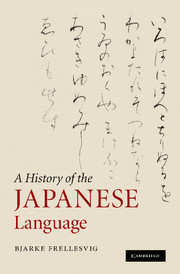Book contents
- Frontmatter
- Contents
- List of tables, maps and figures
- Acknowledgements
- List of abbreviations
- Introduction
- Part I Old Japanese
- Part II Early Middle Japanese
- 6 Writing and sources
- 7 Phonology
- 8 Grammar
- 9 The sinification of Japanese
- Part III Late Middle Japanese
- Part IV Modern Japanese
- Appendix: Summary of the main regular phonemic changes between Old Japanese and conservative Modern Japanese
- References
- Index of main grammatical forms
- General index
6 - Writing and sources
Published online by Cambridge University Press: 03 May 2011
- Frontmatter
- Contents
- List of tables, maps and figures
- Acknowledgements
- List of abbreviations
- Introduction
- Part I Old Japanese
- Part II Early Middle Japanese
- 6 Writing and sources
- 7 Phonology
- 8 Grammar
- 9 The sinification of Japanese
- Part III Late Middle Japanese
- Part IV Modern Japanese
- Appendix: Summary of the main regular phonemic changes between Old Japanese and conservative Modern Japanese
- References
- Index of main grammatical forms
- General index
Summary
Writing
From the late Nara period a gradual process of simplification and abbreviation of the shapes of man'yōgana took place, slowly at first but gaining speed through the early part of the Heian period, and eventually resulting in the development of hiragana and katakana scripts. As the reduced shapes were dissociated from the kanji from which they derived, they unambiguously became phonograms and it became possible to write Japanese phonographically in a simple and straightforward manner. From the beginning of the tenth century until the end of the eleventh century we have a large body of text which was written almost entirely phonographically in hiragana, with only a few logographically used kanji. This style of writing is a continuation of the tradition of extensive phonographic writing which developed in the context of writing or recording poetry in the OJ period. Most of the EMJ hiragana texts were written by women who traditionally were excluded from the world of learning and Classical Chinese. The first line of the Tosa nikki from 935 where its author, Ki no Tsurayuki, somewhat tongue-in-cheek pretends to be a woman trying her hand at writing diaries, is famous: wotoko mo su naru nikki to ipu mono wo wonna mo site mimu tote suru nari ‘I as a woman will also try keeping this thing called diary, which men are said to keep.’
Information
- Type
- Chapter
- Information
- A History of the Japanese Language , pp. 157 - 183Publisher: Cambridge University PressPrint publication year: 2010
